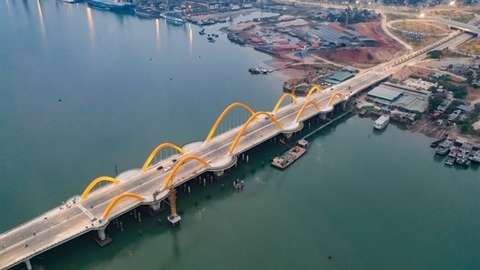
An intersection of Ha Long - Van Don - Mong Cai expressway. — VNA/VNS Photo Huy Hung
In early September, Quang Ninh officially opened the backbone expressway running through Ha Long, Van Don and Mong Cai.
Together with the Cai Lan deep water seaport and Van Don International Airport, the expressway is a modern infrastructure system with large transport capacity, which will create breakthrough developments not only for the province’s economy but also for the Northern Key Economic Region.
Under the national master plan for the 2021-30 period for the Northern Key Economic Region, which includes seven provinces, Quang Ninh is a core growth engine in the economic triangle of Ha Noi – Hai Phong – Quang Ninh.
Statistics of the provincial People’s Committee show that the gross regional domestic product (GRDP) of Quang Ninh expanded by 10.21 per cent in January – October, driven by the impressive recovery of tourism, industry, construction and agro-forestry-fishery sector as normal economic activities resumed after the COVID-19 pandemic.
Quang Ninh was forecast to register a two-digit growth this year, meaning that the northern province had been expanding at two-digit growth annually for eight consecutive years.
Besides administrative reform and human resource development, infrastructure was considered one of three strategic breakthroughs of Quang Ninh for promoting socio-economic development.
Few localities have invested in infrastructure development as strongly as Quang Ninh in recent years.
Several infrastructure projects worth trillions of Vietnamese dong are being implemented, such as the Quang Ninh LNG power project (worth VND47 trillion) and Van Ninh deep water port complex’s first phase (worth $2.24 trillion).
This bucks the trend of the rest of the country, where few infrastructure projects have been invested in following public-private-partnership practices in the past five years. Instead, Quang Ninh has successfully attracted private investment in large-scale projects.
For example, private investment contributed more than 70 per cent to building the 176-km long Ha Long – Van Don – Mong Cai expressway.
Many economic experts said that modern and synchronous infrastructure creates significant attraction for the province to draw investment and create long-term growth drivers, as well as turn Quang Ninh into a driver of growth for the region and the country.
Dare to do
According to Vu Kim Chi, Permanent Deputy Director of the provincial Investment Promotion Agency, five to seven years ago, infrastructure was a bottleneck to investment in Quang Ninh as investors were concerned about traffic connectivity.
However, the province now successfully turned this bottleneck into an advantage. It now has a synchronous transport infrastructure system with highways, airports and seaports, which enables regional, inter-regional and international connectivity.
With efforts to hasten economic reforms, Quang Ninh had created an open investment environment which, for five years straight, topped 63 provinces and cities across the country in terms of the provincial competitive index.
Quang Ninh was also the province with the largest area of industrial and economic zones, a significant advantage for attracting investment, Chi said.
“It can be said that it is the time for Quang Ninh to converge all factors to attract investment. Many investors have been coming to Quang Ninh to explore investment opportunities,” Chi said.
The province has attracted around US$10 billion worth of foreign direct investment. In the first nine months of this year, it attracted $200 million in FDI.
Vu Tien Loc, a member of the National Assembly Economic Committee, said the success of Quang Ninh was thanks to the “dare-to-do” spirit of the local government, coupled with the reform effort to create an open environment for investors, and the prime location of the province.
“Quang Ninh is the international gateway of the northern and northeast regions, so the synchronous and modern investment in infrastructure in the province is meaningful to the province, the whole region, and the country,” Loc said.
Green transition
More than a decade ago, Quang Ninh was a province with an economy heavily dependent on coal mining.
In the 2011-25 period, the local authorities started an ambitious plan to move from a brown economy based on mining to a green economy, which was considered impossible.

A view of Ha Long City, Quang Ninh. — VNA/VNS Photo
With determination and consistency in action, Quang Ninh made spectacular developments in tourism during the past decade, establishing a leading position and successfully transforming its economic model from brown to green.
“Quang Ninh should be considered a national development model,” Tran Dinh Thien, former Director of the Viet Nam Institute of Economics, said.
Thien pointed out that the key to the success of Quang Ninh was the harmonisation of benefits of the State and the private sector.
Thien said that to move forward on the road of green transition, Quang Ninh needs to focus on promoting high and clean technologies in industrial zones and building clean industry, which would play an important role in ensuring the environment for tourism – these are “must-dos” and “can-do”.
Quang Ninh also set out a roadmap by 2025 that it would stop mining and close all quarries to preserve the environment.
According to the provincial People’s Committee, Quang Ninh would continue to pursue an economic development strategy associated with environmental production, focusing on attracting projects with modern and environmentally friendly technologies.
By 2030, Quang Ninh aims to become a dynamic and comprehensive development centre, international tourism centre, marine economic centre, a gateway of the Northern Key Economic Region, and the whole country with sustainable urban development adaptive to climate change.
Early in June, the provincial People’s Committee approved the project of comprehensive digital transformation across the province by 2025 with a vision to 2030, which stressed that the digital transformation would create impetus for growth and the shortage way to breakthrough development, improving productivity, efficiency and competitiveness of the economy and promoting the role of Quang Ninh as a dynamic and comprehensive development centre of the Northern region. — VNS